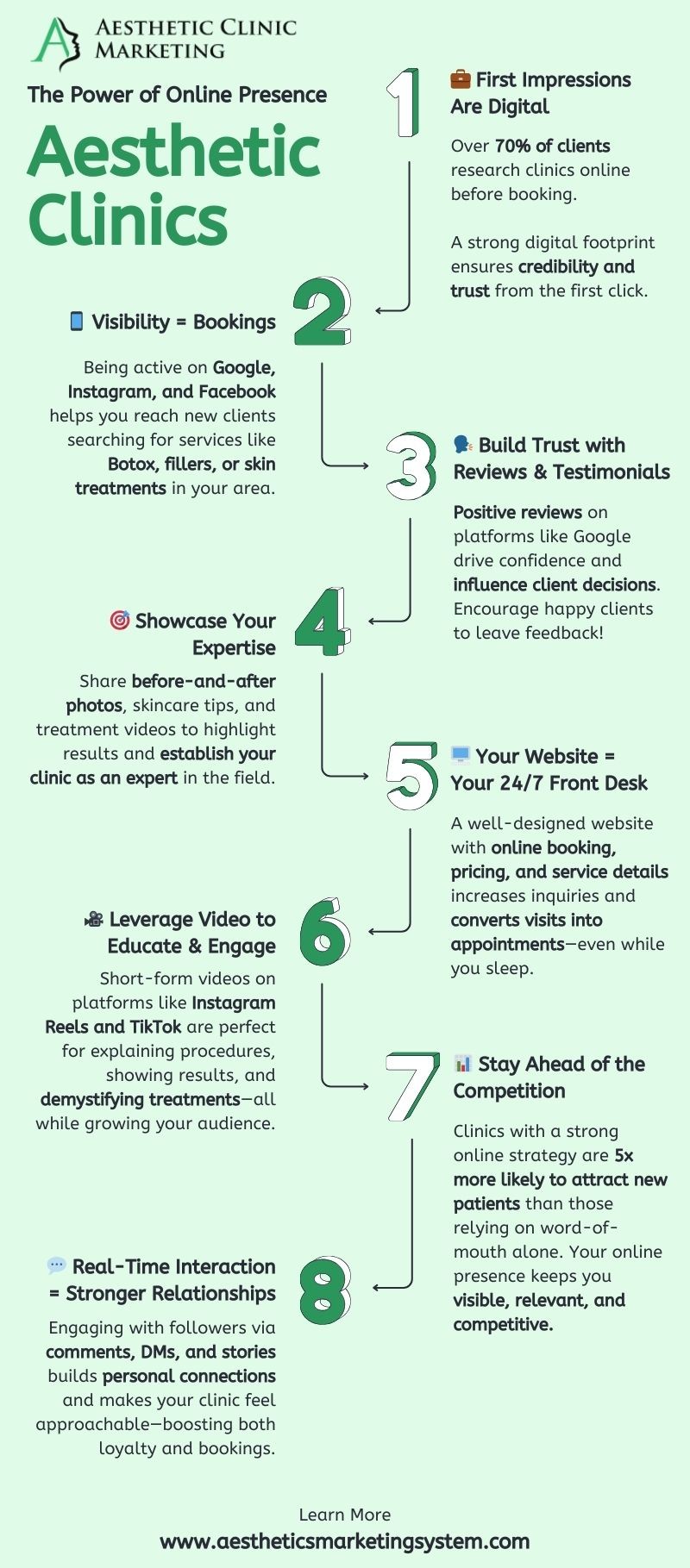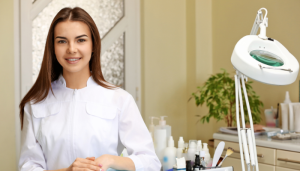Client-Boosting Content Marketing for Aesthetics Clinics

Table of Contents
ToggleWant More Clients at Your Aesthetic Clinic? Start with Smarter Content.
If your treatment chairs are empty more often than you’d like, the problem might not be your skills—but your visibility. Today’s clients are scrolling, not strolling. And they’re making decisions long before they walk through your door.
This blog will show you how to turn simple content—like blog posts, social media updates, and quick videos—into powerful tools that attract, educate, and convert. Ready to stop blending in and start standing out?
Key Takeaways
Identify your target audience to tailor your content effectively.
Use visual storytelling and client testimonials to create engaging content.
Optimise your website and social media for a better online presence.
Be transparent and share authentic client experiences to build trust.
Measure your success by tracking engagement metrics and adjusting strategies.
Understanding Content Marketing For Aesthetics
Content marketing? For aesthetics clinics? Sounds a bit fancy, right? But honestly, it’s just about creating stuff people actually want to see and read.
Think of it as showing off what you know and building trust, rather than just shouting about your services. It’s a longer game, but it pays off.
Defining Your Target Audience
Okay, first things first: who are you trying to reach? It’s not enough to say ‘anyone who wants to look better’. Get specific. Are you targeting younger people interested in preventative treatments? Or maybe older clients looking for anti-ageing solutions?
Knowing your audience inside and out is key. Think about things like:
Age range
Typical budget
Common concerns (e.g., wrinkles, acne, scarring)
Where they hang out online (Instagram, Facebook, etc.)
Once you’ve got a clear picture of your ideal client, you can start creating content that speaks directly to them. It’s like tailoring a suit – it fits better and looks amazing.
Identifying Key Content Types
So, what kind of stuff should you be making? Loads of options here. Blog posts are great for in-depth info, videos are super engaging, and social media posts are perfect for quick updates and behind-the-scenes glimpses. Here are a few ideas:
‘Before and After’ photos: These are gold! Just make sure you have client consent, obviously.
Treatment explainers: Demystify those procedures! What are they, how do they work, and what are the benefits?
Skincare tips: Give away some free advice. It builds trust and positions you as an expert.
Establishing Brand Voice
Your brand voice is basically your clinic’s personality. Are you friendly and approachable? Or more serious and clinical? It needs to be consistent across all your content.
Think about:
Tone: Humorous? Informative? Empathetic?
Language: Formal or informal?
Values: What’s important to your clinic? (e.g., patient safety, natural results, cutting-edge technology)
Make sure your brand voice reflects who you are and who you want to attract. It’s what makes you, you.
Creating Engaging Content Strategies
Utilising Visual Storytelling
Okay, so everyone says visuals are important, but how do you actually use them? Think beyond just slapping up a before-and-after photo. Consider short videos showcasing a treatment, or even animated explainers about how a certain procedure works.
People love to see the process, not just the result. It makes it feel more real and less like some airbrushed fantasy.
Incorporating Client Testimonials
Client testimonials are gold, but they need to be done right. Don’t just stick a quote on your website and call it a day. Get video testimonials if you can – seeing someone talk about their positive experience is way more impactful than reading it.
And make sure they’re specific! “I loved it!” is useless. “My skin feels amazing, and the fine lines around my eyes have really softened” is much better.
Developing Educational Resources
Be the go-to source for information about aesthetics. Create blog posts, guides, and even short courses that explain different treatments, skincare ingredients, and what to expect during and after procedures.
This builds trust and positions you as an expert.
Providing clear, accurate information not only helps potential clients make informed decisions but also reduces anxiety and builds confidence in your clinic’s expertise. It’s a win-win.
Here are some ideas for educational content:
“The Ultimate Guide to Chemical Peels”
“Understanding the Different Types of Dermal Fillers”
“How to Prepare for Your First Laser Hair Removal Session”
Optimising Your Online Presence

Enhancing Your Website's User Experience
Okay, so your website is like the digital shop front for your clinic. If it’s clunky, slow, or just plain confusing, people are gonna bounce. You want to make it as easy as possible for potential clients to find what they need and book an appointment.
Think about it: if someone’s looking for a quick Botox fix, they don’t want to spend ages trying to figure out your booking system.
Here are a few things to think about:
Site speed: Nobody likes waiting for a page to load. Optimise your images and code to make sure everything’s snappy.
Mobile-friendliness: Loads of people browse on their phones, so your site needs to look good and work well on smaller screens.
Clear navigation: Make it obvious where people need to click to find information about treatments, pricing, and how to book.
A good user experience isn’t just about looking pretty; it’s about making it effortless for people to become clients. If your website is a pain to use, you’re losing business, simple as that.
Leveraging Social Media Platforms
Social media is where a lot of potential clients are hanging out, so you need to be there too. But it’s not enough just to have a profile; you need to use it properly. Think of your social media profiles as mini-versions of your clinic.
Make sure they accurately show off your brand, give key info, and make it easy for people to get in touch or book.
Here’s a quick checklist:
Complete profile: Fill out all sections fully, using keywords that people might use to find a clinic like yours.
Eye-catching visuals: Use good-quality images for your profile, cover photos, and posts.
Regular posting: Keep your feed active with interesting and useful content.
Implementing Local SEO Techniques
Local SEO is all about making sure your clinic shows up when people search for aesthetic treatments in your area. If someone Googles “Botox near me,” you want your clinic to be one of the first results they see. It’s about getting your clinic seen by people who are actually likely to become clients.
Here’s how to boost your local SEO:
Google Business Profile: Claim and optimise your Google Business Profile. Make sure all your information is correct and up-to-date.
Local keywords: Use local keywords throughout your website content, like “aesthetic clinic Birmingham” or “dermal fillers London.”
Online reviews: Encourage clients to leave reviews on Google and other sites. More positive reviews can help you rank higher.
Building Trust Through Transparency
Trust is everything in the aesthetics business. People are putting their faces (and bodies!) in your hands, so they need to feel safe and informed. Here’s how to build that crucial trust through being upfront and honest.
Sharing Authentic Client Experiences
Client testimonials are great, but they need to feel real. Avoid overly polished, obviously-scripted reviews. Instead, focus on sharing genuine stories.
Use video testimonials where clients speak in their own words.
Show before-and-after photos that accurately reflect typical results (warts and all!).
Encourage clients to share their experiences on independent review sites.
It’s better to have a few honest reviews that highlight both the positives and any minor drawbacks than a load of generic, glowing ones that no one believes.
Providing Clear Treatment Information
Don’t hide behind jargon or gloss over potential risks. Give clients all the information they need to make informed decisions.
Explain the procedure in plain English, avoiding technical terms where possible.
Be upfront about potential side effects and recovery times.
Offer detailed pre- and post-treatment instructions.
Encouraging Open Communication
Make it easy for clients to ask questions and voice concerns.
Provide multiple channels for communication (phone, email, social media).
Respond to enquiries promptly and thoroughly.
Create a safe space where clients feel comfortable discussing their anxieties.
Communication Channel | Average Response Time | Client Satisfaction Score |
|---|---|---|
Phone | 2 minutes | 95% |
4 hours | 88% | |
Social Media | 6 hours | 75% |
Measuring Success in Content Marketing
Alright, so you’ve been putting in the effort with your content marketing. Now, how do you actually know if it’s working? It’s not just about throwing stuff out there and hoping for the best. You need to track, analyse, and adjust. Let’s get into it.
Tracking Engagement Metrics
Okay, first things first: engagement. This is all about how people are interacting with your content. Are they liking, sharing, commenting? Are they actually reading your blog posts, or just scrolling through?
Here’s a few things to keep an eye on:
Social Media Likes, Shares, and Comments: Pretty self-explanatory. More is generally better, but also look at the quality of the comments. Are people asking questions, showing genuine interest, or just posting emojis?
Website Traffic: Use Google Analytics (or similar) to see how many people are visiting your site, which pages they’re looking at, and how long they’re staying. A sudden spike in traffic after a new blog post? That’s a good sign.
Blog Post Read Time: Most platforms will give you an average read time. If people are only spending 10 seconds on a 5-minute article, something’s wrong. Maybe the content isn’t engaging, or maybe it’s not what they expected.
Analysing Conversion Rates
Engagement is great, but ultimately, you want people to become clients, right? That’s where conversion rates come in. This is about turning those interested readers into paying customers.
Here’s what to look at:
Enquiry Form Submissions: How many people are filling out your contact forms after reading a blog post or visiting a specific page? Track where they came from (e.g., which blog post led them to the form).
Booking Rates: Are people booking consultations or treatments directly from your website? Again, track which content led them there.
Lead Magnet Downloads: If you’re offering free guides or resources in exchange for email addresses, how many people are downloading them? This shows interest and gives you a way to follow up.
Adjusting Strategies Based on Feedback
So, you’ve got all this data. Now what? Well, it’s time to actually use it.
Don’t just collect metrics for the sake of it. Use them to understand what’s working and what’s not, and then make changes to your strategy accordingly.
Here’s how:
Identify Top-Performing Content: What topics are getting the most engagement and conversions? Create more content like that.
Identify Underperforming Content: What’s not working? Is it the topic, the format, the writing style? Try different approaches or scrap it altogether.
A/B Test Different Approaches: Try two different headlines for the same blog post and see which one gets more clicks. Experiment with different social media posts to see what resonates with your audience. A/B testing can be really useful.
Metric | Example | Action |
|---|---|---|
Low Blog Read Time | Average read time: 30 seconds | Improve content quality, readability, or target a more specific audience |
High Social Engagement | Lots of likes and shares on Instagram post | Create more visual content, run similar campaigns |
Low Enquiry Submissions | Few form submissions from a landing page | Revamp the landing page, improve the call to action |
It’s all about being flexible and willing to adapt. Content marketing isn’t a one-size-fits-all thing. You need to find what works for your clinic and your audience. Good luck!
Collaborating with Influencers and Partners
Identifying Suitable Influencers
Finding the right influencers can feel like a bit of a minefield, but it’s worth getting right. Start by thinking about who your ideal client follows. Are there local beauty bloggers? Or maybe lifestyle gurus who align with your clinic’s values? Look for authenticity and engagement over sheer follower count.
A smaller, more dedicated audience can often yield better results. Check their past collaborations – do they fit with your brand’s image? It’s also worth using tools to analyse their audience demographics to ensure they match your target market.
Creating Joint Marketing Campaigns
Once you’ve found some promising influencers, it’s time to brainstorm campaign ideas. Think beyond just asking them to post a photo of themselves after a treatment. Consider offering exclusive discounts to their followers, hosting a joint giveaway, or even creating a series of educational videos together.
The key is to create something that feels authentic and provides value to their audience. I once saw a clinic partner with a local yoga studio for a ‘wellness and skincare’ event, and it was a huge success!
Building Long-Term Partnerships
Don’t just think of influencer collaborations as one-off events. The real magic happens when you build long-term relationships. This means staying in touch with your influencers, supporting their work, and finding ways to collaborate on an ongoing basis.
Maybe they could become a brand ambassador for your clinic, or you could feature them in your blog posts.
Building these relationships takes time and effort, but the payoff can be huge. Think of it as investing in a valuable asset for your clinic’s marketing strategy.
Here’s a quick guide to building those partnerships:
Consistent Communication: Keep in touch regularly, not just when you need something.
Mutual Support: Share their content and engage with their posts.
Exclusive Opportunities: Offer them early access to new treatments or services.
Navigating Advertising Guidelines for Aesthetics
Understanding Regulatory Requirements
When you’re dealing with aesthetics, it’s a whole different ball game. You’ve got to be super careful about what you say and how you say it. The key thing is to get familiar with the rules. Check out the CAP Code (Committee of Advertising Practise) and any guidelines from bodies like the MHRA (Medicines and Healthcare products Regulatory Agency). They’re there to keep everyone safe and sound, including your clients.
Crafting Compliant Marketing Messages
Right, so you know the rules, but how do you actually put them into practise? Well, first off, avoid making claims that sound too good to be true. We’ve all seen those ads that promise instant results with zero effort. That’s a big no-no.
Be realistic about what your treatments can achieve, and always include information about potential risks or side effects. Honesty is the best policy, after all. And make sure any before-and-after photos are genuine and accurately reflect the results people can expect.
Ensuring Ethical Practises
Advertising isn’t just about following the letter of the law; it’s also about doing what’s right. That means putting your clients’ well-being first. Don’t pressure people into treatments they don’t need, and always give them all the information they need to make an informed decision.
It’s also worth thinking about the language you use. Avoid anything that could be seen as exploiting people’s insecurities or promoting unrealistic beauty standards.
Remember, you’re not just selling treatments; you’re selling confidence and self-esteem. So, make sure you’re doing it in a way that’s responsible and ethical.
It’s easy to get caught up in the excitement of marketing your clinic, but it’s important to take a step back and make sure you’re doing things the right way. By following the advertising guidelines and putting your clients first, you can build a brand that’s both successful and trustworthy.
Conclusion
Content marketing is one of the easiest ways to get noticed by the people who are already looking for services like yours. A helpful blog post, a quick skincare tip, or a transformation story can do more than just fill your feed—they can fill your appointment book.
If you’re feeling unsure about what to post or how to start, you’re not alone. To make things easier, here’s a FREE website plan created just for aesthetics clinics—no pressure, just helpful ideas to get moving in the right direction.
Frequently Asked Questions
What is content marketing for aesthetics clinics?
Content marketing for aesthetics clinics involves creating and sharing valuable information to attract and engage potential clients. This can include blog posts, videos, and social media content that educate clients about treatments and services.
How can I identify my target audience?
To identify your target audience, think about who your ideal clients are. Consider their age, gender, interests, and what they might be looking for in aesthetic treatments. You can also use surveys or social media insights to gather more information.
What types of content should I create?
You can create various types of content such as educational articles about procedures, client testimonials, before-and-after photos, and videos demonstrating treatments. This variety helps keep your audience engaged.
How can I improve my clinic's online presence?
To boost your online presence, make sure your website is user-friendly and informative. Use social media to connect with clients and share your content. Also, consider using local SEO techniques to help people find your clinic.
Why is it important to share client experiences?
Sharing client experiences builds trust and credibility. When potential clients see real results and hear positive feedback from others, they are more likely to feel confident in choosing your clinic.
How do I measure the success of my content marketing?
You can measure success by tracking engagement metrics like likes, shares, and comments on social media, as well as monitoring website traffic and conversion rates. This data helps you understand what works and what needs improvement.








